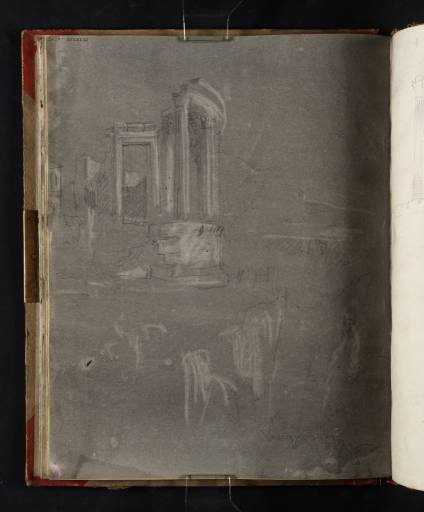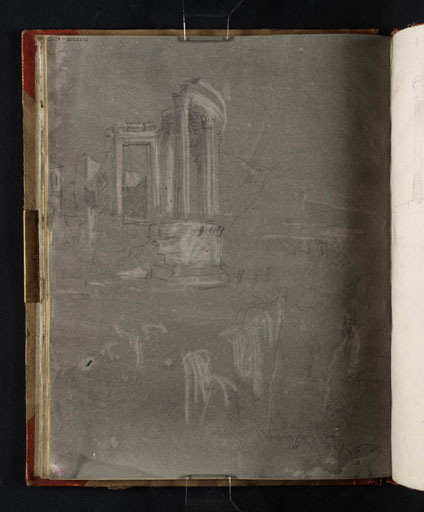Joseph Mallord William Turner The So-Called Temple of Vesta, Tivoli 1819
Image 1 of 2
Joseph Mallord William Turner,
The So-Called Temple of Vesta, Tivoli
1819
Joseph Mallord William Turner 1775–1851
Folio 47 Recto:
The So-Called Temple of Vesta, Tivoli 1819
D15518
Turner Bequest CLXXXIII 47
Turner Bequest CLXXXIII 47
Pencil and grey watercolour wash on white wove paper, 253 x 200 mm
Inscribed by ?John Ruskin in faded red ink ‘47’ bottom left, inverted, and by an unknown hand in pencil ‘47’ top left, inverted
Stamped in black ‘CLXXXIII 47’ top left, inverted
Inscribed by ?John Ruskin in faded red ink ‘47’ bottom left, inverted, and by an unknown hand in pencil ‘47’ top left, inverted
Stamped in black ‘CLXXXIII 47’ top left, inverted
Accepted by the nation as part of the Turner Bequest 1856
Exhibition history
1974
Turner 1775–1851, Royal Academy, London, November 1974–March 1975 (226, as ‘The Temple of the Sibyl seen from Below’).
2001
William Turner: Licht und Farbe, Museum Folkwang, Essen, September 2001–January 2002, Kunsthaus Zürich, February–May 2002 (91, reproduced in colour).
References
1909
A.J. Finberg, A Complete Inventory of the Drawings of the Turner Bequest, London 1909, vol.I, p.541, as ‘Do. [Temple of the Sibyl]’.
1974
Martin Butlin, Andrew Wilton and John Gage, Turner 1775–1851, exhibition catalogue, Royal Academy, London 1974, no.226, pp.88, 91, as ‘The Temple of the Sibyl seen from Below’.
1979
Andrew Wilton, The Life and Work of J.M.W. Turner, Fribourg 1979, pp.141–2, reproduced p.138, pl.148, as ‘The Temple of the Sibyl seen from below’.
1984
Cecilia Powell, ‘Turner on Classic Ground: His Visits to Central and Southern Italy and Related Paintings and Drawings’, unpublished Ph.D thesis, Courtauld Institute of Art, University of London 1984, p.175 note 23.
1987
Cecilia Powell, Turner in the South: Rome, Naples, Florence, New Haven and London 1987, p.78 note 19.
2001
Andrew Wilton, Inge Bodesohn-Vogel and Helena Robinson, William Turner: Licht und Farbe, exhibition catalogue, Museum Folkwang, Essen 2001, no.91, pp.[155], 159, reproduced in colour.
The so-called Temple of Vesta is an ancient circular edifice dating from the first century BC which stands on the brink of the valley at the northern edge of Tivoli. During the eighteenth and nineteenth centuries it represented an important site for the study of classical architecture and was one of the most popular motifs for artists visiting Italy. This sketch depicts a view from the promontory on the opposite side of the gorge (present-day Hotel Sirene) looking north, an angle which displays the semi-circle of extant Corinthian columns, as well as the doorway of the inner cella. This vista from a viewpoint virtually level with the ruin, was one adopted by many artists,1 possibly following the compositional precedent set by Giovanni Battista Piranesi (1720–1778) in his etching, Altra vedute del tempio della Sibilla in Tivoli, from the Vedute di Roma.2 Visible in the background is the campanile of the Church of San Giorgio, a building which until the end of the nineteenth century incorporated the remains of the so-called Temple of the Sibyl. Like many drawings within this sketchbook, the composition has been executed over a washed grey background. Turner has created highlights by rubbing or lifting out the wash to reveal the white paper beneath, principally to delineate the architecture of the temple and to emphasise the sheer, craggy drop of the gorge below. Similar sketches can be found in the Tivoli and Rome sketchbook (Tate D15049 and D15095; Turner Bequest CLXXIX 65a and 88). For a detailed description of the Temple of Vesta and other related studies see folio 44 verso (D15513).
See for example British School, 18th Century, Temple of the Sibyl, Tivoli, (Tate, T09115), John ‘Warwick’ Smith (1749–1831), The Temple of Sibyl at Tivoli, (Tate, T08207), and Antoine-Félix Boisselier (1790–1857), The Temple of Vesta at Tivoli circa 1811 (Stanford University Museum of Art), reproduced in Philip Conisbee, Sarah Faunce and Jeremy Strick, In the Light of Italy: Corot and early Open-Air Painting, exhibition catalogue, National Gallery of Art, Washington 1996, no.50, p.163.
Verso:
Blank, except for traces of grey watercolour wash
Blank, except for traces of grey watercolour wash
Nicola Moorby
February 2010
How to cite
Nicola Moorby, ‘The So-Called Temple of Vesta, Tivoli 1819 by Joseph Mallord William Turner’, catalogue entry, February 2010, in David Blayney Brown (ed.), J.M.W. Turner: Sketchbooks, Drawings and Watercolours, Tate Research Publication, December 2012, https://www


